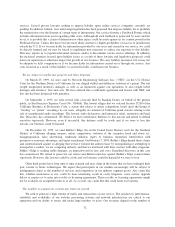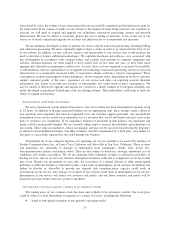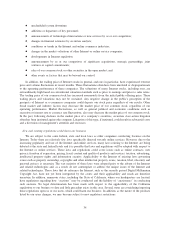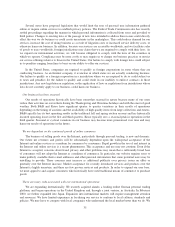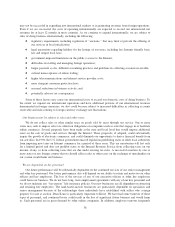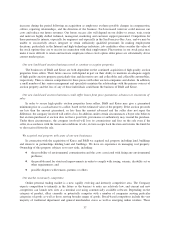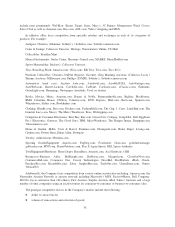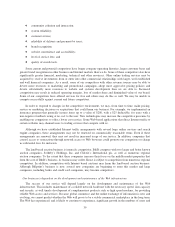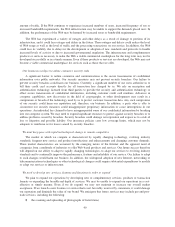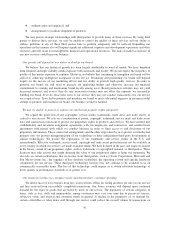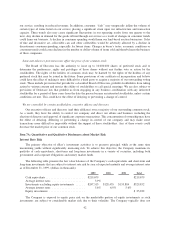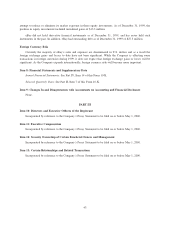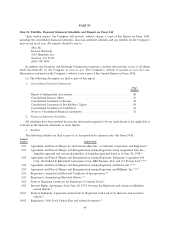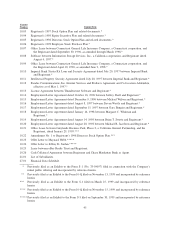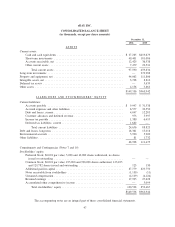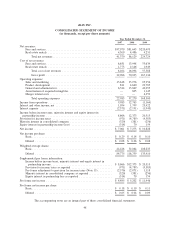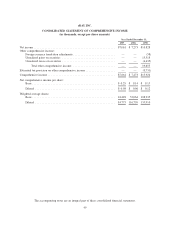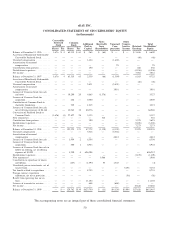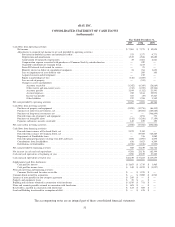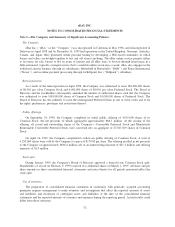eBay 1999 Annual Report Download - page 47
Download and view the complete annual report
Please find page 47 of the 1999 eBay annual report below. You can navigate through the pages in the report by either clicking on the pages listed below, or by using the keyword search tool below to find specific information within the annual report.
our service, resulting in reduced revenues. In addition, consumer ‘‘fads’’ may temporarily inflate the volume of
certain types of items listed on our service, placing a significant strain upon our infrastructure and transaction
capacity. These trends also may cause significant fluctuations in our operating results from one quarter to the
next. Any decline in demand for the goods offered through our service as a result of changes in consumer trends
could harm our business. A decline in consumer spending would harm our land-based auction businesses. Sales
of fine and decorative art, collectable cars and other collectibles would be adversely affected by a decline in
discretionary consumer spending, especially for luxury items. Changes in buyer’s tastes, economic conditions or
consumer trends could cause declines in the number or dollar volume of items sold and thereby harm the business
of these companies.
Some anti-takeover provisions may affect the price of our common stock
The Board of Directors has the authority to issue up to 10,000,000 shares of preferred stock and to
determine the preferences, rights and privileges of those shares without any further vote or action by the
stockholders. The rights of the holders of common stock may be harmed by the rights of the holders of any
preferred stock that may be issued in the future. Some provisions of our certificate of incorporation and bylaws
could have the effect of making it more difficult for a third party to acquire a majority of our outstanding voting
stock. These include provisions that provide for a classified Board of Directors, prohibit stockholders from taking
action by written consent and restrict the ability of stockholders to call special meetings. We are also subject to
provisions of Delaware law that prohibit us from engaging in any business combination with any interested
stockholder for a period of three years from the date the person became an interested stockholder, unless certain
conditions are met. This could have the effect of delaying or preventing a change of control.
We are controlled by certain stockholders, executive officers and directors
Our executive officers and directors (and their affiliates) own a majority of our outstanding common stock.
As a result, they have the ability to control our company and direct our affairs and business, including the
election of directors and approval of significant corporate transactions. This concentration of ownership may have
the effect of delaying, deferring or preventing a change in control of our company and may make some
transactions more difficult or impossible without the support of these stockholders. Any of these events could
decrease the market price of our common stock.
Item 7A: Quantitative and Qualitative Disclosures about Market Risk
Interest Rate Risk
The primary objective of eBay’s investment activities is to preserve principal while at the same time
maximizing yields without significantly increasing risk. To achieve this objective, the Company maintains its
portfolio of cash equivalents, short-term and long-term investments in a variety of securities, including both
government and corporate obligations and money market funds.
The following table presents the fair value balances of the Company’s cash equivalents and short-term and
long-term investments that are subject to interest rate risk by year of expected maturity and average interest rates
as of December 31, 1999, (dollars in thousands):
2000 2001 2002 Total
Cash equivalents ......................... $219,679 $219,679
Average interest rates ..................... 3.9%
Investments excluding equity investments ...... $247,513 $128,455 $153,884 $529,852
Average interest rates ..................... 5.6% 6.0% 5.6%
Equity investments ....................... $ 25,222
The Company is exposed to equity price risk on the marketable portion of equity investments as such
investments are subject to considerable market risk due to their volatility. The Company typically does not
42


